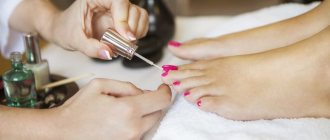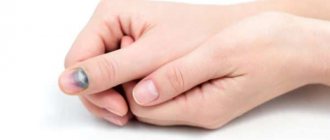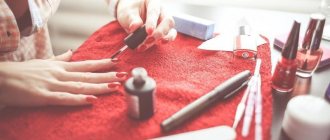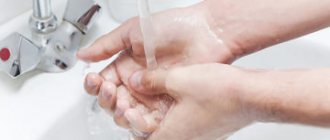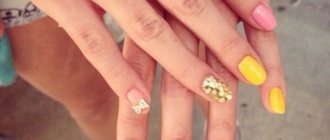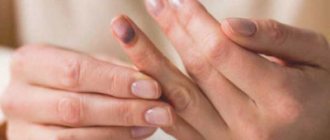What is yellow nail
The yellowness of the nail plate on the hands and feet is a consequence of exposure to any unfavorable external factors, which subsequently lead to pigmentation. Some people are born with a specific nail color that can range from yellow to a distinct orange, but in this case this color is normal. It happens that the color changes and begins to peel off from the nail bed due to loosening the structure of the nail plate, in which case you need to check for fungal infections.
Ways to prevent deformation of the nail plate
It is better to prevent any defect than to treat it. To prevent thickening of the nail plates, experts recommend following certain rules.
Important:
- Regularly take water treatments, use products that can prevent the proliferation of pathogenic microorganisms.
- At the first symptoms of a fungal infection, apply antifungal ointment and make an appointment with a dermatologist.
- After each wash, treat the toenail plates with any emollient cream, oil vitamin or olive oil.
- Make masks during the fresh fruit season.
- Once a week, soak your feet in herbal decoctions made from herbs that have antiseptic and anti-inflammatory properties (chamomile, St. John's wort, oak bark).
- Refuse to use other people's towels and wear other people's shoes.
- You cannot try on new shoes on bare feet, you cannot walk barefoot in public baths and swimming pools.
- It is useful to refuse to wear tight, uncomfortable pairs of shoes or boots; experts recommend purchasing only those shoes that are made from natural materials.
- You need to change your socks every day.
You cannot go barefoot in public baths or swimming pools.
High sweating of the feet creates favorable conditions for the proliferation of fungal diseases. To prevent them, it is useful to use traditional medicine or medications prescribed by a doctor for preventive purposes.
Why do the nails on my big toes turn yellow?
There are many reasons why a yellow toenail appears. At the same time, both men and women suffer from this problem for completely different reasons:
- Often, yellow toenails form when the patient has acute or chronic liver disease. In this case, an uncharacteristic shade of the nails first forms, and then the color of the whites of the eyes and skin becomes yellow.
- Imbalance of microflora. A lack of beneficial microorganisms in the stomach can lead to yellowness and diseases of the internal organs.
- The presence of a fungal infection. In this case, the plate on the toe looks painful, takes on an uncharacteristic color, and the tissue structure of some areas of the nail plate begins to change.
- Middle-aged and elderly people may experience the so-called yellow nail syndrome. In this case, the toenails begin to peel, thicken and change color.
- If the toenail turns yellow and becomes thicker, this may be a consequence of diabetes mellitus or other pathologies, such as psoriasis.
- The plate may become yellow and thick when the immune system is reduced or the protective or nervous system is impaired.
- Failure to comply with hygiene rules can also lead to the appearance of a yellow tint on the nail plates of the feet.
- Excessive sweating or wearing synthetic and uncomfortable shoes is also undesirable. These conditions cause symptoms characteristic of fungus - thickening of the nail and the appearance of white spots.
- With long-term use of antibiotics, you should not be surprised if the nail on your big toe turns yellow, since this factor can also cause the manifestation of the disease.
- Infectious or somatic diseases can affect the color of nails.
- Barbell exercises at home
- Cake with nuts - step-by-step recipes for cooking with dried fruits, chocolate, candied fruits in the oven or slow cooker
- Diarrhea in a baby
Drug treatment for thickened nails
Treatment regimens are developed based on laboratory test transcripts.
If a fungal infection is confirmed, complex therapy is drawn up.
The patient is prescribed:
- taking systemic antifungal drugs (“Mikozoral”, “Binafin”, “Orungal” - the choice of a specific drug is made after identifying the causative agent of the infection);
- the use of products intended for local treatment (they must contain active substances that can stop the proliferation of the fungus);
- use of traditional medicine;
- physiotherapy procedures.
Treatment of fungal infections is long-term; its effectiveness directly depends on how strictly the patient follows the doctor’s instructions.
If the thickening of the nail is caused by injury, no special drug therapy is required: the nail will recover itself over time.
When thickening of the nail plate is caused by a disease of the internal organs, patients are advised to seek help from their attending physician and work with him to develop treatment tactics.
Why do women's toenails turn yellow?
A yellow toenail in women may appear as a result of using low-quality nail coating products (varnishes). The chemical elements contained in the composition, penetrating deep into the keratin, can cause staining of the nails. The lack of a base coat can also affect the color of the plate. When applied, any varnish gives the plate a yellowish tint. The brighter the color, the stronger the staining will be, so you should apply a nail base coat before using any bright polish.
Diagnostics
Before starting any treatment, you must consult a doctor for diagnosis. In order to determine the cause of the appearance of a yellow nail on the big toe, a dermatologist needs to examine the yellowed plate under a specialized lamp and take biomaterial (a piece of a thick plate) for microscopic examination and identification of mycoses. After this, a scraping is taken from the skin around the diseased nail and blood is drawn to detect antibodies to leprosy and syphilis.
- 5 best clinics for joint treatment
- Masks for dry hair
- Foods that reduce immunity
What to do
For any reason of the disease, it is necessary to monitor your lifestyle and proper nutrition. In addition, you should start taking vitamins. If the plate on the big toe has turned yellow or a yellow spot has formed as a result of improper use of nail polishes or prolonged exposure to ultraviolet rays, then they can be bleached. For this procedure, you can use toothpaste or lemon juice.
Drug treatment
Depending on the cause of the disease, your doctor may prescribe various types of medications:
- If the cause of the appearance of yellow spots is problems with the liver (cirrhosis or hepatitis), then in such cases effective drug treatment is carried out using drugs designed for courses (Heptral, Essentiale Forte, etc.). In this case, the overgrown part of the plate requires careful removal.
- Due to decreased immunity, treatment with vitamin and mineral complexes is used. In severe cases, medications aimed at stimulating the functioning of the immune system may be used.
- To treat fungal diseases, varnishes are applied: Loceryl, Mikozan or Batrafen. They are expensive, but they give quick results.
- If the disease is extensive and the fungal infection spreads rapidly, it is necessary to take antibiotics: Diflucan or Fungavis. If a fungal infection leads to deformation of the plate, then ointments are used: Lamisil, Exifin, Thermikon. It is worth considering that the active ingredient of these drugs - ciclopiroxolamine - is effective only in the early stages of foot fungus disease.
Traditional methods
To restore healthy nail color, you can use traditional methods of treatment:
- Yellowing of the plates can be treated with fresh lemon juice . Use a cotton swab dipped in juice or pieces of fruit to wipe your nails every day for a few minutes or make compresses.
- You can eliminate signs of the disease and yellowing of the skin of the feet and nails using a special ointment . To prepare it, you need one tablespoon of 70% vinegar and vegetable oil, then add a raw egg to the solution. The ingredients must be thoroughly mixed and applied to the affected area, wrapped in a clean bandage and put on a warm sock.
- If the color of natural nails changes due to the use of varnish or prolonged exposure to other unfavorable factors, you can use tea tree oil or celandine , which successfully cope with lesions on the skin of the feet. You can use medications at any time of the day, but to maintain the positive effect, you must wear socks. To improve the condition of the nail, you can use nourishing creams.
Warm baths
If yellow stripes form on the tips of your nails, you can use oak bark baths. To prepare a medicinal decoction, you need to mix three tablespoons of oak bark with the same amount of lilac flowers, then add two tablespoons of calendula and one celandine. Pour hot water over the herbs and leave for about a day. After this, the broth must be filtered and used warm for foot baths. This procedure promotes nail growth.
Traditional medicine recipes
There are many recipes that can be used to eliminate this problem.
Here is a list of the most popular of them:
- Fresh lemon juice helps lighten thickened nails. A few drops are applied directly to the plate and rubbed into it. It is advisable to carry out this procedure no more than twice a week.
- Baths with sea salt allow you to strengthen your nails and nourish them with beneficial microelements. To carry them out, it is necessary to choose a comfortable water temperature (36 degrees, no more), the duration of the procedure should not exceed 20 minutes, after the bath it is advisable to dry your feet with disposable napkins, and then treat the skin of your feet and nail plates with softening or medicinal creams and ointments.
- You can fight pathogenic microorganisms with apple cider vinegar baths. The product is mixed with warm water in equal proportions. It is necessary to perform finger bathing in the prepared liquid three times a day. The duration of the procedure is fifteen minutes.
- Baths with a decoction of milkweed help improve the condition of a thickened nail. It is important to take them within twenty minutes, then your feet should dry naturally.
- A decoction of St. John's wort has an excellent antiseptic effect. Baths can be replaced by rubbing juice made from a fresh plant.
- You can calm inflammation and reduce the number of fungal spores using a compress with a cut aloe leaf.
- A mask made from fresh aloe juice (15 grams), two teaspoons of crushed fresh chamomile leaves and a spoon of nourishing face cream has a pronounced strengthening effect. All ingredients are mixed to form a mass that must be applied to the phalanx of the sore finger and left for at least three hours.
- Celandine juice also helps fight fungal infections. It is easy to isolate by refracting the stem of a fresh plant. Directly from there, squeeze out as many drops as you need onto the affected plate and rub the juice into the nail. If treatment is carried out in the winter, you can replace fresh juice with celandine oil.
- An ointment made from aloe juice, onions, garlic, fresh butter and beeswax helps to cope with all the problems that can be caused by thickening of nails. All ingredients are taken in equal quantities (50 grams each), the resulting mass is heated in a water bath (it must be heated until the oil and wax have completely melted). Afterwards, cool and use for rubbing into a thickened plate. The ointment is applied in a thick layer, covered with a cabbage leaf on top, secured with a bandage and left overnight.
A compress with a cut aloe leaf will calm inflammation and reduce the number of fungal spores
The use of these remedies without the use of drug therapy may be ineffective, so alternative treatment should be part of a comprehensive treatment.
Prevention
If the cause of the disease is injury or an infectious disease, then it is impossible to prevent the occurrence of a fungal infection. Otherwise, by adhering to simple rules , you can protect yourself from the occurrence of unpleasant diseases and their consequences:
- You must follow the rules for visiting swimming pools, saunas or fitness centers.
- Before a manicure or pedicure, you must disinfect your instruments.
- Chronic diseases should not be allowed; they can cause yellowing of nails.


